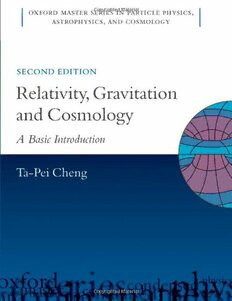
Relativity, Gravitation and Cosmology: A Basic Introduction PDF
Preview Relativity, Gravitation and Cosmology: A Basic Introduction
OXFORDMASTERSERIESINPARTICLEPHYSICS,ASTROPHYSICS,ANDCOSMOLOGY OXFORDMASTERSERIESINPHYSICS The Oxford Master Series is designed for final year undergraduate and beginning graduate students in physics and related disciplines. It has been driven by a perceived gap in the literature today. While basic undergraduate physics textsoftenshowlittleornoconnectionwiththehugeexplosionofresearchoverthelasttwodecades,moreadvanced and specialized texts tend to be rather daunting for students. In this series, all topics and their consequences are treated at a simple level, while pointers to recent developments are provided at various stages. The emphasis in onclearphysicalprincipleslikesymmetry,quantummechanics,andelectromagnetismwhichunderliethewholeof physics. At the same time, the subjects are related to real measurements and to the experimental techniques and devices currently used by physicists in academe and industry. Books in this series are written as course books, and includeampletutorialmaterial,examples,illustrations,revisionpoints,andproblemsets.Theycanlikewisebeused aspreparationforstudentsstartingadoctorateinphysicsandrelatedfields,orforrecentgraduatesstartingresearch inoneofthesefieldsinindustry. CONDENSEDMATTERPHYSICS 1. M.T.Dove:Structureanddynamics:anatomicviewofmaterials 2. J.Singleton:Bandtheoryandelectronicpropertiesofsolids 3. A.M.Fox:Opticalpropertiesofsolids,secondedition 4. S.J.Blundell:Magnetismincondensedmatter 5. J.F.Annett:Superconductivity,superfluids,andcondensates 6. R.A.L.Jones:Softcondensedmatter 17. S.Tautz:Surfacesofcondensedmatter 18. H.Bruus:Theoreticalmicrofluidics 19. C.L.Dennis,J.F.Gregg:Theartofspintronics:anintroduction ATOMIC,OPTICAL,ANDLASERPHYSICS 7. C.J.Foot:Atomicphysics 8. G.A.Brooker:Modernclassicaloptics 9. S.M.Hooker,C.E.Webb:Laserphysics 15. A.M.Fox:Quantumoptics:anintroduction 16. S.M.Barnett:Quantuminformation PARTICLEPHYSICS,ASTROPHYSICS,ANDCOSMOLOGY 10. D.H.Perkins:Particleastrophysics,secondedition 11. Ta-PeiCheng:Relativity,gravitationandcosmology,secondedition STATISTICAL,COMPUTATIONAL,ANDTHEORETICALPHYSICS 12. M.Maggiore:Amodernintroductiontoquantumfieldtheory 13. W.Krauth:Statisticalmechanics:algorithmsandcomputations 14. J.P.Sethna:Statisticalmechanics:entropy,orderparameters,andcomplexity Relativity, Gravitation and Cosmology A Basic Introduction Second Edition TA-PEI CHENG UniversityofMissouri–St.Louis 1 3 GreatClarendonStreet,Oxfordox26DP OxfordUniversityPressisadepartmentoftheUniversityofOxford. ItfurtherstheUniversity’sobjectiveofexcellenceinresearch,scholarship, andeducationbypublishingworldwidein Oxford NewYork Auckland CapeTown DaresSalaam HongKong Karachi KualaLumpur Madrid Melbourne MexicoCity Nairobi NewDelhi Shanghai Taipei Toronto Withofficesin Argentina Austria Brazil Chile CzechRepublic France Greece Guatemala Hungary Italy Japan Poland Portugal Singapore SouthKorea Switzerland Thailand Turkey Ukraine Vietnam OxfordisaregisteredtrademarkofOxfordUniversityPress intheUKandincertainothercountries PublishedintheUnitedStates byOxfordUniversityPressInc.,NewYork (cid:1)c Ta-PeiCheng2010 Themoralrightsoftheauthorhasbeenasserted DatabaserightOxfordUniversityPress(maker) Firstedition2005 Secondedition2010 Allrightsreserved.Nopartofthispublicationmaybereproduced, storedinaretrievalsystem,ortransmitted,inanyformorbyanymeans, withoutthepriorpermissioninwritingofOxfordUniversityPress, orasexpresslypermittedbylaw,orundertermsagreedwiththeappropriate reprographicsrightsorganization.Enquiriesconcerningreproduction outsidethescopeoftheaboveshouldbesenttotheRightsDepartment, OxfordUniversityPress,attheaddressabove Youmustnotcirculatethisbookinanyotherbindingorcover andyoumustimposethesameconditiononanyacquirer BritishLibraryCataloguinginPublicationData Dataavailable LibraryofCongressCataloginginPublicationData Dataavailable TypesetbySPIPublisherServices,Pondicherry,India PrintedinGreatBritain onacid-freepaperby CPIAntonyRowe,Chippenham,Wiltshire ISBN 978–0–19–957363–9(Hbk.) 978–0–19–957364–6(Pbk.) 1 3 5 7 9 10 8 6 4 2 Contents Preface xi PARTI PRELIMINARIES 1 Introductionandoverview 3 1.1 Relativityasacoordinatesymmetry 5 1.1.1 FromNewtonianrelativitytoether 5 1.1.2 Einsteinianrelativity 6 1.1.3 Coordinatesymmetrytransformations 7 1.1.4 Newkinematicsanddynamics 8 1.2 GRasagravitationalfieldtheory 8 1.2.1 Einstein’smotivationsforthegeneraltheory 8 1.2.2 Geometryasgravity 10 1.2.3 Mathematicallanguageofrelativity 11 1.2.4 ObservationalevidenceforGR 12 1.2.5 GRastheframeworkforcosmology 14 Reviewquestions 14 2 Specialrelativity:Thebasics 15 2.1 Coordinatesymmetries 15 2.1.1 NewtonianphysicsandGalileansymmetry 18 2.1.2 ElectrodynamicsandLorentzsymmetry 19 2.1.3 Velocityadditionruleamended 21 2.2 Thenewkinematics 22 2.2.1 Thebasicpostulatesofspecialrelativity 22 2.2.2 Relativityofequilocalityandsimultaneity 23 2.2.3 Timedilationandlengthcontraction 26 2.3 Lorentztransformation 28 2.3.1 Physicalmeaningofvarioustransformation terms 30 2.3.2 Therelativisticinvariantinterval 31 2.3.3 Relativityistrulyrelative 32 2.3.4 TwoparadoxesasillustrativeSRexamples 32 Reviewquestions 35 Problems 36 vi Contents PARTII RELATIVITY:METRICDESCRIPTIONOFSPACETIME 3 Specialrelativity:Thegeometricformulation 41 3.1 Minkowskispacetime 42 3.1.1 Basisvectors,themetricandscalarproduct 43 3.1.2 TheMinkowskimetricandLorentztransformation 45 3.2 Four-vectorsforparticledynamics 47 3.2.1 Thevelocity4-vector 47 3.2.2 Relativisticenergyandmomentum 48 3.3 Thespacetimediagram 51 3.3.1 Basicfeaturesandinvariantregions 52 3.3.2 Lorentztransformationinthespacetime diagram 53 3.4 ThegeometricformulationofSR:Asummary 56 Reviewquestions 57 Problems 58 4 Theprincipleofequivalence 61 4.1 Newtoniangravitationpotential—areview 61 4.2 EPintroduced 63 4.2.1 Inertialmassvs.gravitationalmass 63 4.2.2 EPanditssignificance 66 4.3 ImplicationsofthestrongEP 67 4.3.1 Gravitationalredshiftandtimedilation 69 4.3.2 Lightraydeflectioncalculated 74 4.3.3 Energyconsiderationsofagravitatinglightpulse 77 4.3.4 Einstein’sinferenceofacurvedspacetime 78 Reviewquestions 79 Problems 79 5 Metricdescriptionofacurvedspace 81 5.1 Gaussiancoordinates 82 5.2 Metrictensor 83 5.2.1 Geodesicastheshortestcurve 86 5.2.2 LocalEuclideancoordinates 88 5.3 Curvature 90 5.3.1 Gaussiancurvature 91 5.3.2 CurvaturemeasuresthedeviationfromEuclidean relations 92 5.3.3 Spaceswithconstantcurvature 94 Reviewquestions 98 Problems 98 6 GRasageometrictheoryofgravity–I 100 6.1 Geometryasgravity 100 6.1.1 EPphysicsandawarpedspacetime 102 6.1.2 Curvedspacetimeasagravitationalfield 103 Contents vii 6.2 GeodesicequationasGRequationofmotion 105 6.2.1 Thegeodesicequationrecalled 105 6.2.2 TheNewtonianlimit 107 6.3 Thecurvatureofspacetime 109 6.3.1 Tidalforceasthecurvatureofspacetime 110 6.3.2 TheGRfieldequationdescribed 113 Reviewquestions 115 Problems 116 7 Sphericallysymmetricspacetime–GRtests 117 7.1 DescriptionofSchwarzschildspacetime 118 7.1.1 Propertiesofasphericallysymmetricmetrictensor 118 7.1.2 TheSchwarzschildgeometryandtheembedding diagram 121 7.2 Gravitationallensing 124 7.2.1 Lightraydeflection:GRvs.EP 124 7.2.2 Thelensequation 125 7.3 GeodesicsinSchwarzschildspacetime 129 7.3.1 PrecessionofMercury’sperihelion 130 7.3.2 TheShapirotimedelayofalightsignal 135 Reviewquestions 138 Problems 139 8 Blackholes 141 8.1 Nonrotatingblackholes 142 8.1.1 Timemeasurementsaroundablackhole 143 8.1.2 Eddington–Finkelsteincoordinates:Blackholes andwhiteholes 145 8.1.3 Kruskalcoordinatesandthewormhole 151 8.2 Orbitsandaccretiondisksaroundablackhole 155 8.2.1 EffectivepotentialoftheSchwarzschildspacetime 156 8.2.2 Thebindingenergyofaparticlearoundablackhole 157 8.3 Physicalrealityofblackholes 158 8.3.1 Thelongroadtotheacceptanceoftheblackhole’s reality 158 8.3.2 Observationalevidenceofblackholes 159 8.4 AppendixA:Rotatingsourceofgravity 161 8.4.1 Propertiesofanaxiallysymmetricmetrictensor 161 8.4.2 KerrgeometryandthePenroseprocess 164 8.4.3 BeyondtheSchwarzschildandKerrblackholes 170 8.5 AppendixB:Blackholesandquantumphysics 171 8.5.1 ThePlanckscale 171 8.5.2 Hawkingradiation 172 8.5.3 Blackholethermodynamics 173 8.5.4 Blackholesandquantumgravity 174 Reviewquestions 175 Problems 176 viii Contents PARTIII COSMOLOGY 9 Thehomogeneousandisotropicuniverse 181 9.1 Thecosmosobserved 182 9.1.1 Matterdistributiononthecosmicdistancescale 182 9.1.2 Cosmologicalredshift:Hubble’slaw 184 9.1.3 Ageoftheuniverse 186 9.2 Massdensityoftheuniverse 188 9.2.1 Luminousmatterandthebaryonicdensity 189 9.2.2 Darkmatterandthetotalmassdensity 190 9.3 Thecosmologicalprinciple 194 9.4 TheRobertson–Walkerspacetime 195 9.4.1 Themetricinthecomovingcoordinatesystem 195 9.4.2 DistancesintheRWgeometry 197 Reviewquestions 202 Problems 203 10 Theexpandinguniverseandthermalrelics 205 10.1 Friedmannequations 206 10.1.1 TheGRfieldequationsforcosmology 206 10.1.2 Thequasi-Newtonianinterpretation 208 10.2 Timeevolutionofmodeluniverses 212 10.3 Bigbangcosmology 215 10.3.1 Scale-dependenceofradiation’stemperature 215 10.3.2 Differentthermalequilibriumstages 217 10.4 Primordialnucleosynthesis 220 10.5 PhotondecouplingandtheCMB 223 10.5.1 Theuniversebecametransparenttophotons 224 10.5.2 ThediscoveryofCMBradiation 225 10.5.3 Photons,neutrinosandtheradiation–matter equalitytime 226 10.5.4 CMBtemperaturefluctuation 230 Reviewquestions 234 Problems 235 11 Inflationandtheacceleratinguniverse 237 11.1 Thecosmologicalconstant 238 11.1.1 Vacuumenergyassourceofgravitational repulsion 240 11.1.2 Einstein’sstaticuniverse 241 11.2 Theinflationaryepoch 243 11.2.1 InitialconditionsfortheFLRWcosmology 244 11.2.2 Theinflationscenario 246 11.2.3 Inflationandtheconditionsitleftbehind 248 11.3 CMBanisotropyandevidenceforaflatuniverse 251 11.3.1 Threeregionsoftheangularpowerspectrum 251 11.3.2 Theprimarypeakandspatialgeometryof theuniverse 254 Contents ix 11.4 Theacceleratinguniverseinthepresentepoch 256 11.4.1 Distantsupernovaeandthe1998discovery 257 11.4.2 Transitionfromdecelerationtoacceleration 261 11.4.3 Darkenergy:Furtherevidenceandthemystery ofitsorigin 264 11.5 Theconcordantpicture 265 11.6 AppendixC:Falsevacuumandhiddensymmetry 268 11.7 AppendixD:Quantumvacuumenergyasthe cosmologicalconstant 271 Reviewquestions 274 Problems 274 PARTIV RELATIVITY:FULLTENSORFORMULATION 12 Tensorsinspecialrelativity 279 12.1 Generalcoordinatesystems 280 12.1.1 Contravariantandcovariantcomponents 281 12.1.2 Coordinatetransformations 282 12.1.3 PositionanddeloperatorsinMinkowskispacetime 284 12.2 Manifestlycovariantformalismforelectromagnetism 286 12.2.1 Theelectromagneticfieldtensor 286 12.2.2 Electricchargeconservation 290 12.3 Energy–momentumtensors 291 Reviewquestions 296 Problems 296 13 Tensorsingeneralrelativity 298 13.1 Derivativesinacurvedspace 299 13.1.1 Generalcoordinatetransformations 299 13.1.2 Covariantdifferentiation 302 13.1.3 Christoffelsymbolsandthemetrictensor 304 13.2 Paralleltransport 307 13.2.1 Componentchangesunderparalleltransport 307 13.2.2 Thegeodesicasthestraightestpossiblecurve 308 13.3 Riemanniancurvaturetensor 309 13.3.1 Thecurvaturetensorinann-dimensionalspace 311 13.3.2 Symmetriesandcontractionsofthecurvaturetensor 313 Reviewquestions 315 Problems 316 14 GRasageometrictheoryofgravity–II 318 14.1 Theprincipleofgeneralcovariance 319 14.1.1 Theminimalsubstitutionrule 319 14.1.2 GeodesicequationfromSRequationofmotion 320 14.2 Einsteinfieldequation 321 14.2.1 Findingtherelativisticgravitationalfieldequation 321 14.2.2 NewtonianlimitoftheEinsteinequation 323
